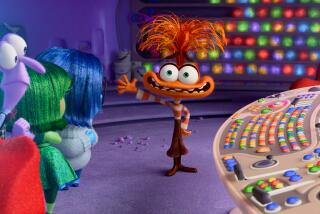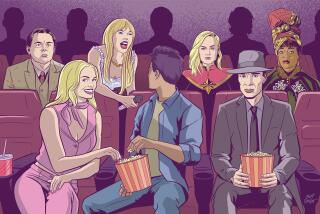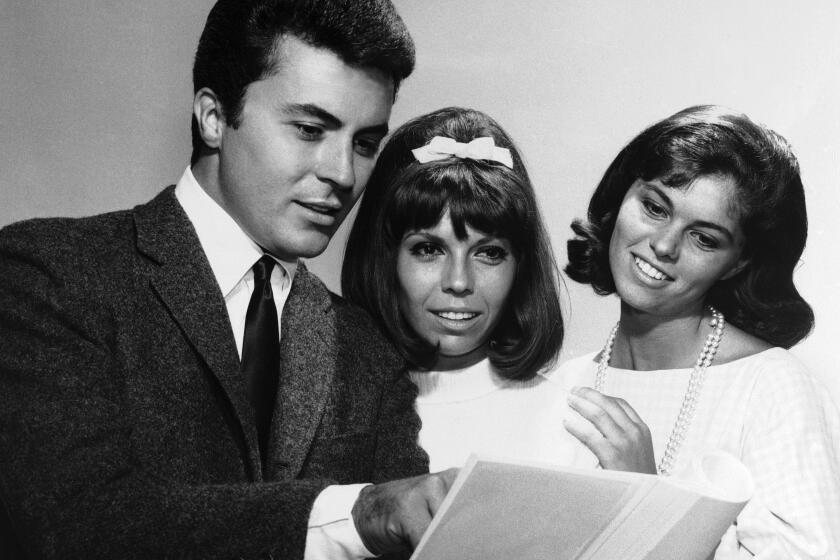Asphalt Bijou : Summer Tradition Thrives at a Chatsworth Drive-In
Troy Nelson had angled his car into the perfect little spot. Darkness was falling. His date, 19-year-old Michelle Miller, sat in the passenger seat beside him, waiting. In only moments, Nelson was going to do something he had never done before: watch a drive-in movie.
“This is the first time,” the 23-year-old college student confessed, a little sheepishly. But, cinematically speaking, he vowed to go all the way: to catch not only the first feature, “Problem Child 2,” but to stay for the second, “Backdraft,” as well.
They were far from alone. By dusk on a balmy Friday night in the San Fernando Valley, nearly 2,000 cars had converged at a sprawling asphalt complex with no fewer than six screens to take part in one of suburbia’s vanishing summer rites. For tonight, at least, a bygone era was alive and playing. The gated ticket booths of the “Winnetka 6” in Chatsworth--one of the largest drive-ins ever opened in Los Angeles--looked like the toll plaza of the Golden Gate Bridge at rush hour. Portions of the 29-acre grounds resembled certain unyielding stretches of the Santa Ana Freeway.
One early arrival, Joe Dvorsky of Van Nuys, took a spray bottle to the car windshield so that no unwanted smudges would mar his family’s view of Arnold Schwarzenegger in “Terminator 2.”
“All I hope is that they never close drive-ins,” his wife, Sylvia, said, praising the virtues of a $4.50 adult admission price--with children under 12 free.
But drive-ins--a relic of the car culture that came to prominence in the 1940s and ‘50s--are indeed fading fast from the American scene. Over the last decade, the outdoor theaters have been biting the dust faster than Schwarzenegger’s celluloid foes. Check this body count: 10 years ago, there were 3,354 drive-in screens in the United States; now, the total is down to 910, including about 50 in Los Angeles County and 160 in California. And more are expected to close in the years ahead.
How bad is the downturn? Well, the trend is being carefully monitored by NATO--the National Assn. of Theatre Owners, based in North Hollywood.
“It’s been a precipitous drop,” said NATO’s Jim Kozak, who offered many possible reasons for the nationwide decline: decades of rising land values, cable television and VCRs, the evolution of the multiscreen, Dolby-sound indoor theater, and the standardization, in the late 1960s, of daylight-saving time, which has pushed dusk back by an hour in the summertime.
Kozak noted that other influences may be accountable as well, including periodic gasoline shortages--which may have damaged the drive-in business in the 1970s--and, not least of all, the sexual revolution.
“Drive-ins no longer serve a prime purpose as a making-out point,” he said. “Mind you, these are all just theories.”
In Los Angeles, especially, the impact of the real-estate market seems clearly apparent. The Winnetka 6 complex opened 14 years ago on an otherwise vacant expanse of land worth less than $4 a square foot. But it is doubtful the same complex could be established today because development of the north Valley has brought homes, businesses and industrial plants and pushed commercial property values to $25 to $35 a square foot, said David DeFore of CB Commercial real estate.
The same is true across the suburbs--which is why the Winnetka 6 remains one of the last drive-ins ever built in the county.
“I don’t think there have been any new ones opened (in Los Angeles) in the last decade,” said Milton Moritz of Pacific Theatres Corp., who described the Winnetka as one of the chain’s top-grossing operations. “Today, with land costs, you have to go way, way out (of the city) to build.”
Moritz said it is unlikely that outdoor theaters will ever completely disappear, but he described them as a phenomenon of the 1940s and 1950s, when land was cheap and suburbs were springing up far and wide. From 1933, when the first drive-in opened in Camden, N.J., until 1958, when an all-time high of 4,063 screens were in use, every new community seemed in a rush to get a drive-in.
“People would put the kids in the station wagon and off they went,” Moritz said. “(The drive-ins) had playgrounds. People would put their kids in pajamas and they’d fall asleep in the back seat while you watched the movie. It was a tradition.”
Nowadays, only a flicker of that era remains, but in some families the flame still burns with surprising incandescence. On this night at the Winnetka, with 15 movies playing on a bill that included three triple-features, Gary and Debbie Kidney of Sylmar were members of such a family. Toting their two young children and a teen-age babysitter, they arrived well over an hour before showtime to be first in line for “Robin Hood,” a move that won them their favorite viewing spot: dead center on row 3.
“We brought pizza and made a picnic out of it,” a happy Gary Kidney boasted.
With twilight fading in a pinkish glow, familiar rituals were visible everywhere: cars jockeying back and forth in search of that ideal viewing angle; families scurrying into the snack bar for popcorn and hot dogs.
Some patrons set up camp atop van roofs and in folding chairs. The Rangel family--Juvenal and Mary and three children--were squeezed into a Volkswagen Beetle amid a mountain of pillows, blankets and Thermos bottles.
It was soon apparent that drive-in technology has improved; gone were the clunky metal speakers of years past. Now, tiny clamps affix to the car antenna, transmitting improved “Cine-Fi” sound over the AM radio.
Up in the main building, projectionist Tom Spunbarg was unburdened by the need to change reels. A series of rotating, five-foot “platters” now held entire movies, feeding them automatically to the projector. There was virtually nothing for Spunbarg to do unless something went wrong; he couldn’t even hear the movies.
“Our biggest challenge is throwing enough light on the screen,” he said as the machines droned on and the lamphouses burned with 4,500-watt bulbs, more than twice the power used in most walk-in theaters.
From his concrete crow’s nest, each screen was nearly 1,000 feet away.
“We could crank up more power,” he said, “but we could burn a hole in the film.”
Although some critics say the images on a drive-in screen are sometimes too dim, too dark, one young couple was making no such complaint. Cuddled together in the open deck of a pickup truck, Bret Frydenberg and Michelle Stevens were taking in their second drive-in movie in a month. Tonight they were seeing “Robin Hood.”
And last time?
“Oh, God . . .” Frydenberg said, groping to remember. But he and his date both came up blank, and all they could do was laugh.
More to Read
Only good movies
Get the Indie Focus newsletter, Mark Olsen's weekly guide to the world of cinema.
You may occasionally receive promotional content from the Los Angeles Times.









